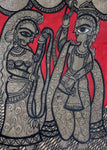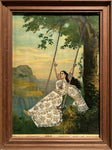7 Paintings That Reveal the Story of Frida Kahlo’s Tragic Life
Frida Kahlo, the famous Mexican painter, was known as much for her bold self-portraits, as she was for her tragic life. Called a ‘surrealist’ by some because of her symbolic art that was often dreamlike, she in fact, considered herself a ‘realist’, and denounced the surrealist tag. Frida’s art was not based on her dreams, but rather on tragedies, events and relationships from her life. Here are 7 of Frida Kahlo’s most significant works of art, painted during different stages in her life, that reflect her emotions, pain, and state of mind at the time:
 (Frida Kahlo in a Tehuna Costume, with her Pet Hawk, 1939; Photo by Nickolas Muray)
(Frida Kahlo in a Tehuna Costume, with her Pet Hawk, 1939; Photo by Nickolas Muray)
1. The Bus or El Autobus, (1929)
In 1925, when Frida Kahlo was 18 years old, she was in a near fatal bus accident. Although Frida never painted anything that directly portrayed the accident, there are a few paintings that allude to it, of which ‘El Autobus’ is the most significant. This painting is said to be a depiction of the passengers of the bus just before the accident. The young woman on the right corner is said to be Frida herself while the man in the blue work overalls, is said to be the man who pulled out a handrail that was impaled in Frida’s pelvis. The diversity across the different people depicts different classes of Mexican society.

2. Frida and Diego Rivera (1931)
Frida married fellow artist, Diego Rivera in 1929 and this relationship was the second ‘grave accident’ of her life, according to Frida. This 1931 painting was made two years after they got married, and Frida drew this as a wedding portrait. In the painting, Diego is portrayed as a very large man, while Frida is tiny and birdlike next to him. He is holding a set of paintbrushes and palette and she is in traditional Mexican attire, which is what he wanted her to wear. In this painting, Frida lets her husband take the limelight as the master artist, as she takes on her role as his supportive and adoring wife. The light manner in which Frida clasps Diego’s hand can be read as a sign that Diego did not belong to her completely, perhaps because of his extramarital affairs.

3. The Two Fridas (1939)
One of Frida Kahlo’s most recognizable paintings, this double self-portrait features two versions of Frida, one in a Mexican costume and the other in a European costume. The painting was finished around the time of Frida’s divorce with Diego Rivera, and depicts her heartbreak and sense of loneliness at the time. The painting is also a question of identity, since the Mexican Frida was the Frida that Diego loved and the European influenced Frida was who she was before their marriage. The fact that the two Fridas are holding hands can be read as her two identities coming together after the divorce, to get over the heartache. The stormy sky filled with clouds allude to Frida’s inner turmoil. Frida and Diego did get back together shortly after the divorce, but the marriage continued to be as tumultuous as before.

4. Self-Portrait with Cropped Hair (1940)
Painted shortly after the divorce with Diego Rivera, this painting is the way Frida reclaimed her identity after the split. In the painting, Frida is wearing an oversized man’s suit, presumed to be Diego’s. She holds scissors in her hands and is surrounded by locks of her own hair. Frida cut off her hair after the divorce as a sign of departure from the relationship, because Diego really loved her hair. Her outfit also is her defiance against Rivera’s preference to always see her dressed in traditional Mexican attire. The lyrics written over her figure are from a Mexican song, translating to: "Look, if I loved you it was because of your hair. Now that you are without hair, I don't love you anymore."

5. Self-Portrait with Thorn Necklace and Hummingbird (1940)
Frida Kahlo was familiar with European and American art of the day, but her personal style showcased a ‘naïve’ and indigenous perspective. As she matured as an artist, she used more traditional Mexican symbols in her art, as seen in this painting. The self-portrait is riddled with symbols of bad luck, such as the black cat on her left shoulder, and the spider monkey on her right. There is a crown of thorns piercing her neck due to which she is bleeding, but her facial expression suggests she is enduring the pain, much like she did all through her life due to physical ailments. The hummingbird, which is a traditional symbol for love charms, hangs dead from the thorns, symbolic of her failed relationship.

6. The Wounded Deer (1946)
'The Wounded Deer’ is one of Frida’s most emotional paintings. The arrows that pierce though the body of the deer with Frida’s head, represent her back pain, and her frustration after the failure of a surgery that was supposed to reduce it. The deer is also an Aztec symbol for her right leg, which Frida lost to gangrene. The setting of the painting, with dead trees and broken branches, is also dreary and hopeless. On the bottom left, Frida wrote the word ‘Carma’, or fate, implying her sadness at not being able to change her own destiny.

7. Still Life with Parrot and Flag (1951) and Still Life with Flag (1954)
Towards the end of her life, Frida refrained from painting herself and began to paint a lot of still life. Her interest in Mexican politics was frequently represented by the placement of a Mexican flag in her paintings. In the 1950’s, her health declined rapidly. She was taking a lot of painkillers, often with alcohol, which affected her art. She could no longer paint all the details that her earlier works were so rich with. These two paintings were made three years apart, and the drastic changes in her decreasing ability is evident in comparison. The second painting was made shortly before her death on the 13th of July, 1954.
 Still Life with Parrot and Flag (1951)
Still Life with Parrot and Flag (1951)
 Still Life with Flag (1954)
Still Life with Flag (1954)
Frida Kahlo had a short life, dying at the young age of 47. Despite living a life filled with pain and tragedy, she rose to become one of the most important women artists of the 20th century. Frida remains an inspiration for her spirit and is a beacon for feminist and women’s empowerment movements all over the world.






















































































